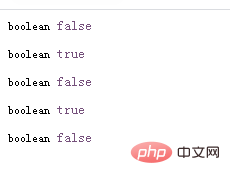Home >Backend Development >PHP Problem >How to check null values using PHP (4 methods)
In the previous article "PHP Array Learning: How to Remove Blank or Duplicate Elements", we learned that we can use the empty() function to determine whether a value is empty. So what are the ways to check null values in PHP? This time we will learn about several common methods. If you need it, you can learn about it~
The theme of today’s article is: using PHP to detect whether a value is empty or not. Okay, let’s get straight to the point. Here are some common methods.
Method 1: Use empty()
empty function: detect whether the variable is "empty"
Any uninitialized variable, the value is 0 or false or empty string "" or null variables, empty arrays, objects without any attributes will be judged as TRUE.
Let’s take a closer look at the code example:
<?php
$a = 'test';
$b = array('key1' => 'value1');
$class = new stdClass();
var_dump(empty($c)); // 输出 bool(true)
var_dump(empty($b['key2'])); // 输出 bool(true)
var_dump(empty($class)); // 输出 bool(false)
var_dump(empty($class->test->test)); // 输出 bool(true)
class EmptyClass{};
$empty_class = new EmptyClass();
var_dump(empty($empty_class));// 输出 bool(false)
?>Output result:

The following variables will be considered empty Is empty:
"" (empty string)
0 (0 as an integer)
0.0 (0 as a floating point number)
"0" (0 as a string)
NULL
FALSE
array() (an empty array)
$var; (one declared, But variables with no value)
Learn about
0,'0','',null、falseThe difference between these five types.
null means non-existence: the value is not stored in the zval space at the bottom of PHP, only a type mark IS_NULL is stored.
And 0, '0', '', false these four exist, the bottom layer of php is to open up zval space storage, with value and type.
string '0' is not equal to string ''
int 0 is equal to string '' null, (non-identical comparison, PHP will do type conversion)
string '0' is not equal to null, int 0 is equal to null
Method 2: Use isset()
isset function: determine whether the variable has been initialized and can be used to test whether the variable has been configured. Returns true if the variable already exists; returns false otherwise.
Let’s take a look at the code example below:
<?php $a = 'test'; $b = array('key1' => 'value1'); $class = new stdClass(); var_dump(isset($class->test->test)); // 判断对象属性是否定义:输出 bool(false) var_dump(isset($a)); // 判断变量是否定义:输出 bool(true) var_dump(isset($c)); // 判断变量是否定义:输出 bool(false) var_dump(isset($b['key1'])); // 判断数组元素是否定义:输出 bool(true) var_dump(isset($b['key2'])); // 判断数组元素是否定义:输出 bool(false) ?>
Output result:

Method 3: Use is_null()
is_null function: detect whether the variable is "null".
When a variable is assigned a value of "null", the detection result is true; 0, empty string, false, and empty array are all detected as false.
Let’s take a closer look at the code example:
<?php $a = null; $b = false; var_dump(is_null($a)); var_dump(is_null($b)); var_dump(is_null($c)); ?>
Output result:

Method 4: Use == or === operator
can use var == null to determine whether the variable is "null". When a variable is assigned a value of "null", the detection result is true; while 0, empty string, false, and empty array are all detected as false. If the variable is not initialized, the program will report an error.
The essence is that the == expression will perform automatic type conversion on the variables on both sides, so the judgment result is true.
Let’s take a look at the code example below:
<?php $a = 0; $b = array(); var_dump($a == null); var_dump($b == null); var_dump($c == null); ?>
var === null To detect whether the variable is "null", the type of the variable must also be "null". When judging "null", equal to is_null has the same effect.
<?php $a = 0; $b = false; $c = 0.0; $d = null; $e = ''; var_dump(0 === $a); // 输出 bool(true) var_dump(0 === $b); // 输出 bool(false) var_dump(0 === $c); // 输出 bool(false) var_dump(0 === $d); // 输出 bool(false) var_dump(0 === $e); // 输出 bool(false) var_dump('' === $e); // 输出 bool(true) var_dump('' === $a); // 输出 bool(false) var_dump('' === $b); // 输出 bool(false) var_dump(0.0 === $c);// 输出 bool(true) var_dump(0.0 === $a); // 输出 bool(false) ?>
The above is the detailed content of How to check null values using PHP (4 methods). For more information, please follow other related articles on the PHP Chinese website!